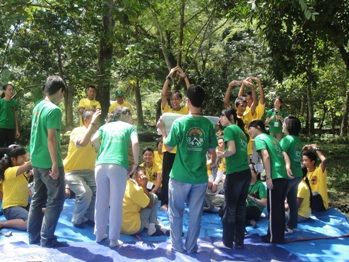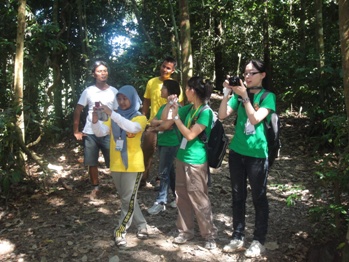From July 23-25, Taiwanese undergraduates held a camp in Bukit Lawang, Sumatra, that taught local high school students to use technology as a conservation tool. The Taiwanese volunteers aimed to help local people in this popular rainforest tourism destination to use the Internet to research and promote sustainable tourism practices. The high school students, who had no formal training in using the Internet, learned to use email, produce a blog, conduct research, and use GPS devices to create a map of part of the local trail system.
The 12 volunteers from National Chiao Tung University, a leading technological university in Taiwan, hope to empower the local community to use technology to further ecotourism. Sustainable tourism is crucial to the wellbeing of the local ecosystem and community, providing an alternative to unsustainable logging and palm oil plantations. It’s particularly important in Bukit Lawang because many of Sumatra’s critically endangered orangutans live here, including some that have been rehabilitated and returned to the wild. The park forms part of Gunung Leuser National Park, recognized by UNESCO as a biosphere reserve and World Heritage Site, which holds the dubious nickname of “Last Stand of the Orangutan.”
 Students play educational games to learn about park rules and conservation. Photo courtesy of Melanie Jae Martin. |
The volunteers held classes for local students in a community learning center created by the Orangutan Information Center (OIC), an NGO that works to educate rural Sumatrans about living sustainably with their forests, along with the Bamboo Community University Association (BCUA). The center includes computers with free Internet access for local people. In collaboration with several other NGOs, these organizations worked together to sponsor the camp.
The Taiwanese volunteers planned and led the camp under the oversight of OIC staff, educating students about park guidelines and conservation as well as using technology such as the Internet and GPS devices. While trekking, students took photos of the trail using cameras with built-in GPS devices. Later, when they uploaded the photos onto a computer, the GPS data allowed them to pinpoint the location of the photos on a map. Ultimately they will produce and publicize a website that gives potential visitors a guided tour of the park, in hopes of raising funds for conservation efforts.
“Students say maybe we can use Internet for tourism,” says Chu Chu Wang, a volunteer, remarking that students became excited about what they can do with the help of technology. Thus far, few people in the community have used Internet to promote their guesthouses and other businesses, so those who create websites have a strong advantage. And tourism provides an incentive for local people to preserve their environment, while also providing money to conservation efforts through donations and a portion of park fees. Keeping tourism sustainable presents an ongoing challenge for Bukit Lawang, but it has helped to protect some of the last remaining orangutan habitat in the world, as well as the habitat of many other endangered species.
 Students and volunteers take photos in the rainforest. Photo courtesy of Melanie Jae Martin. |
Local people can also use Internet to familiarize potential visitors with park guidelines and information about the rainforest ecosystem, so they know what to expect. If people understand what “leave no trace” practices involve, as well as safety regulations such as not coming closer than 10 meters to an orangutan, they may have a much more pleasant experience in the park. They’ll be more likely to follow safety regulations, ensuring that orangutans as well as humans remain safe and healthy. Since orangutans are highly susceptible to human diseases, sharing roughly 97% of human DNA, educating visitors about safety practices is crucial.
Furthermore, students who go on to work as park guides can research information on the Internet to learn more about orangutans and their habitat, as well as ecotourism practices. Many guides strive to improve their knowledge through personal observation as well as visiting the local OIC and WWF information centers, but the Internet gives them the ability to take more control over their own learning.
The volunteers also hope to use the website to inspire others in their home country to protect important ecosystems like Sumatra’s rainforests, which are disappearing at a dramatic rate.
This is the first year the camp has taken place, but the volunteers hope it will be the first of many, and that National Chiao Tung University will have a longstanding relationship with the Orangutan Information Center and Bukit Lawang.
Related articles
Indonesian people-not international donors or orangutan conservationists-will determine the ultimate fate of Indonesia’s forests

(07/29/2010) Many of the environmental issues facing Indonesia are embodied in the plight of the orangutan, the red ape that inhabits the islands of Borneo and Sumatra. Orangutan populations have plummeted over the past century, a result of hunting, habitat loss, the pet trade, and human-ape conflict. Accordingly, governments, charities, and concerned individuals have ploughed tens of millions of dollars into orangutan conservation, but have little to show in terms of slowing or reversing the decline. The same can be said about forest conservation in Indonesia: while massive amounts of money have been put toward protecting and sustainable using forests, the sum is dwarfed by the returns from converting forests into timber, rice, paper, and palm oil. So orangutans—and forests—continue to lose out to economic development, at least as conventionally pursued. Poor governance means that even when well-intentioned measures are in place, they are often undermined by corruption, apathy, or poorly-designed policies. So is there a future for Indonesia’s red apes and their forest home? Erik Meijaard, an ecologist who has worked in Indonesia since 1993 and is considered a world authority on orangutan populations, is cautiously optimistic, although he sees no ‘silver bullet’ solutions.
Hope for survival as isolated orangutans joined by rope bridge

(04/11/2010) Researchers in the Malaysian state of Sabah in Borneo are joyful after receiving confirmation that a young male orangutan used a rope bridge to cross a river, which has separated one orangutan population from another. Due to logging and clearing forests for oil palm plantations, which cover 18 percent of land in Sabah, orangutans on the Kinabantangan River have been cut into fragmented populations.

(03/01/2010) It is no secret that orangutans are threatened with extinction because their rain forests are being destroyed at an alarming rate. Ten years ago, Shawn Thompson, a writer, former journalist and university professor, set out to chronicle the threat to orangutans in a book released in March 2010. The book is called The Intimate Ape: Orangutans and the Secret Life of a Vanishing Species. The book spends most of the time talking about the nature of orangutans and the relationships between orangutans and people. But the ultimate underlying message is there about the source of the peril to orangutans and the solution. Thompson says that the problem of saving orangutans has to do with communications and human nature.